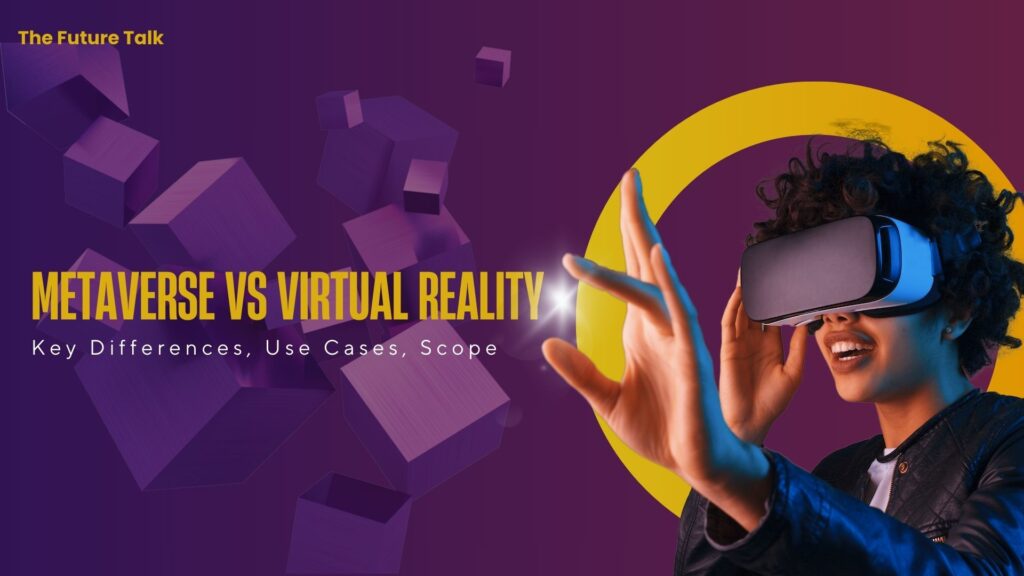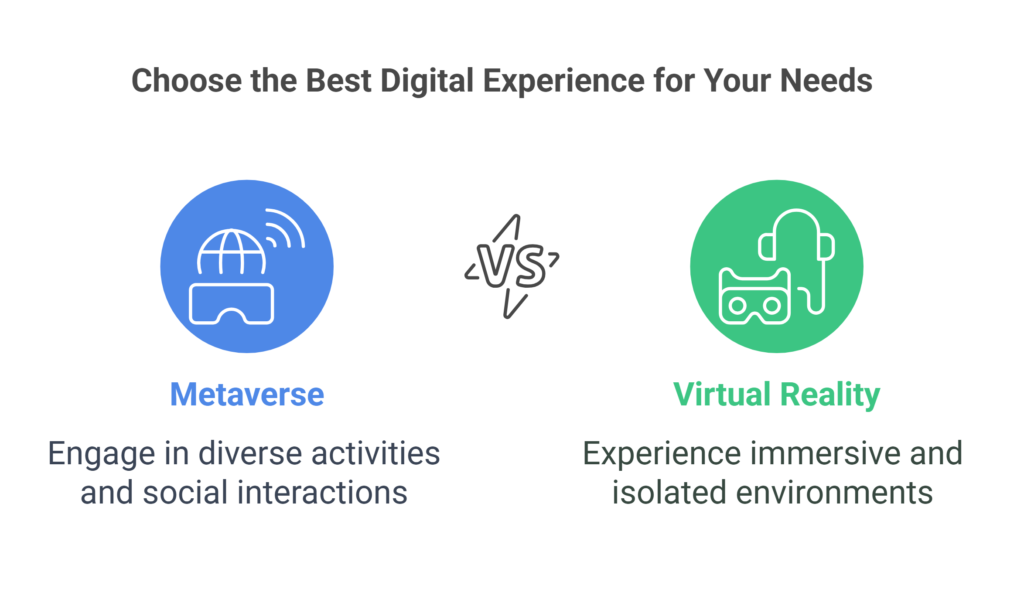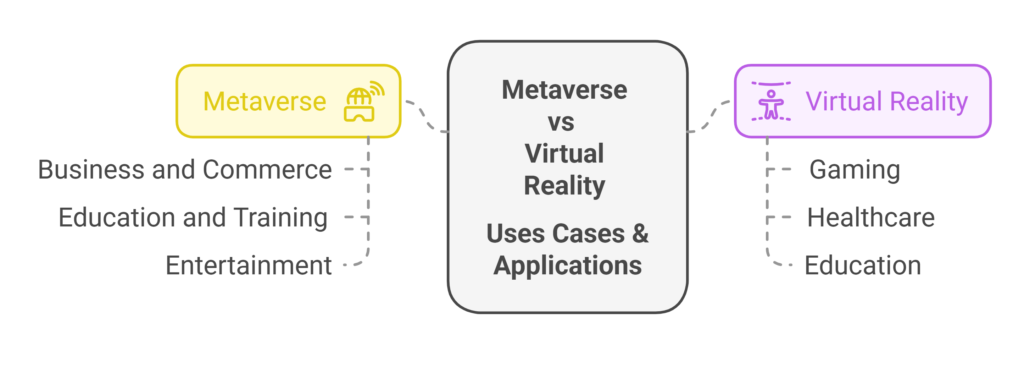
Today’s world has entered a mixed reality – technology that combines virtual reality (VR) and augmented reality (AR). This creates a real-world environment where real and virtual subjects and objects interact in real time. With rapid technology advancements, we now have Metaverse which took the virtual world to the next level.
But do not confuse metaverse with virtual reality. Although these two share some common ground, their potential, applications, and implications significantly differ. It is no surprise that both technologies offer interactive and immersive environments and even change the way we learn, work, and connect with others.
This article will delve into key differences between the metaverse and virtual reality (VR) and provide a detailed comparison of metaverse vs virtual reality. It also highlights the scope and environment, use cases, and future scope of the metaverse and virtual reality.
Also Read: Virtual Reality in Marketing Revolutionizing Consumer Experience
Key Differences Between Metaverse and Virtual Reality
“Metaverse” and “Virtual Reality” are often used interchangeably. These two refer to different ideas in the field of immersive and digital technology. Although they share similar applications, they are very different in terms of potential, consequences, and applications. Let us dive into what each term means, how they overlap, and where they differ.
The following table showcases key differences between metaverse and virtual reality.
| Metaverse | Virtual Reality |
| Always accessible | Short adventure |
| Can own Avatars and land with real-time value | Do not keep anything from the virtual |
| Web connecting virtual world | Separate islands with standalone experiences |
| Dependent on strong internet connection and interoperable platforms | Requires devices and equipment for immersive experiences |
| Still in its infancy and exploring new capabilities | Developed technology with readily available |
Metaverse
The Metaverse is referred to as a collective virtual shared space, developed by the convergence of virtually enhanced physical reality and physically persistent virtual reality.
Metaverse covers VR, AR, and other digital spaces. It is a 3D online universe that combines several virtual spaces, akin to a future version of the internet. Users can interact with a computer-generated environment and other users.
Virtual Reality (VR)
Virtual Reality is a simulated experience that can be similar to or completely different from the real world. It involves using a VR headset to create an immersive environment, which can be used for gaming, entertainment, training, and more. The user is fully immersed in a digital environment, blocking out the physical world.
Metaverse vs Virtual Reality: Scope and Environment
Beyond VR, the concept of the Metaverse is broad. It encompasses social media, the internet, augmented reality, and more. It seeks to seamlessly merge the digital and real worlds.
Users can do a range of activities in the Metaverse, from shopping to going to virtual concerts and having business meetings to interacting with others in a virtual environment. For instance, websites like Roblox and Decentraland provide areas for user interaction in intricate, ever-changing settings.
VR is a subset of the Metaverse, emphasizing the creation of an immersive digital experience through the use of headsets and other devices. VR environments are usually isolated experiences, such as engaging in a game or training simulation. For instance, games like surgical training programs or video games like Beat Saber provide immersive, focused environments without a persistent digital world.
Also Read: How Can Virtual AI Tutors Transform Teaching and Learning?
Potential Impact of Metaverse and Virtual Reality on Social Interactions
The Metaverse places a strong emphasis on teamwork and social engagement. Real-time meetings and collaboration allow users to build a feeling of community and shared experiences.
Platforms like Horizon Worlds by Meta (formerly Facebook) aim to create social spaces where users can interact, build, and create together. These spaces are persistent, meaning they continue to exist and evolve even when individual users are offline.
In VR, interaction is frequently restricted to the particular program being used. Multiplayer games, for instance, let interaction inside the game’s boundaries. Users can converse on social VR platforms such as VRChat, however, these interactions are limited to the VR environment and do not last outside of the session.

Virtual Reality vs Metaverse: Technology and Infrastructure
Blockchain is used in the Metaverse to establish digital ownership, cryptocurrencies are used for transactions, and AI is used to create dynamic, interactive experiences. For instance, in the Metaverse, digital assets are owned via NFTs (Non-Fungible Tokens). It needs a strong infrastructure to enable high-speed internet, superior processing power, and smooth integration across various digital environments.
Hardware like motion sensors, haptic feedback devices, and headgear (like the Oculus Rift and HTC Vive) are the main components of VR. Games, simulations, and VR applications are all included in the package. To produce immersive experiences, virtual reality (VR) needs high-performance computation, graphical processing power, and specialized gear.
Metaverse vs Virtual Reality: Use Cases and Applications

Metaverse
Business and Commerce: Within the Metaverse, virtual marketplaces, digital advertising, and virtual real estate are all flourishing industries. Businesses such as Gucci and Nike have developed virtual goods and environments.
Education and Training: Professional development and distance learning are facilitated by the use of training simulations and virtual classrooms.
Entertainment: New methods to consume and engage with media are made possible by the growing popularity of virtual concerts, movie screenings, and art galleries.
Virtual Reality
Gaming: VR gaming is one of the most popular VR applications, and games like Half-Life: Alyx are pushing the limits of what is possible to experience in a VR game.
Healthcare: VR is used in healthcare for surgical training, psychological counseling, and pain management. VR simulations, for example, provide risk-free training for surgeons.
Education: Virtual reality (VR) provides immersive educational experiences, like interactive history classes and virtual field trips.
Future Prospects
The future of the Metaverse and virtual reality is vast and multifaceted. These technologies hold the potential to revolutionize the way we interact with digital content, combining our online and offline lives. The evolution of the metaverse will be largely dependent on the development of Web3, decentralized platforms, and interoperability across various virtual environments.
VR will continue expanding as long as software and technology developments make experiences more accessible and immersive. The use cases and applications of VR will advance when it is integrated with other technologies like AI and AR.
Conclusion
Virtual reality and the Metaverse are interconnected, although they reflect distinct aspects of the development of digital technology. Whereas VR focuses on creating intense personal experiences, the Metaverse covers a larger, more integrated digital environment. Both have special uses and possible effects that will revolutionize how we communicate with digital content and one another in the future.
Stay tuned to The Future Talk for more such interesting topics. Comment your thoughts and join the conversation.
Excellent!!
I like the valuable information you provide in your articles. I抣l bookmark your blog and check again here frequently. I am quite sure I will learn plenty of new stuff right here! Best of luck for the next!